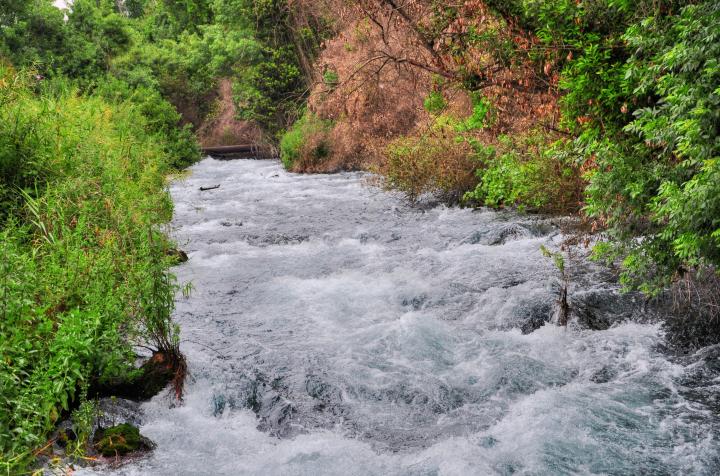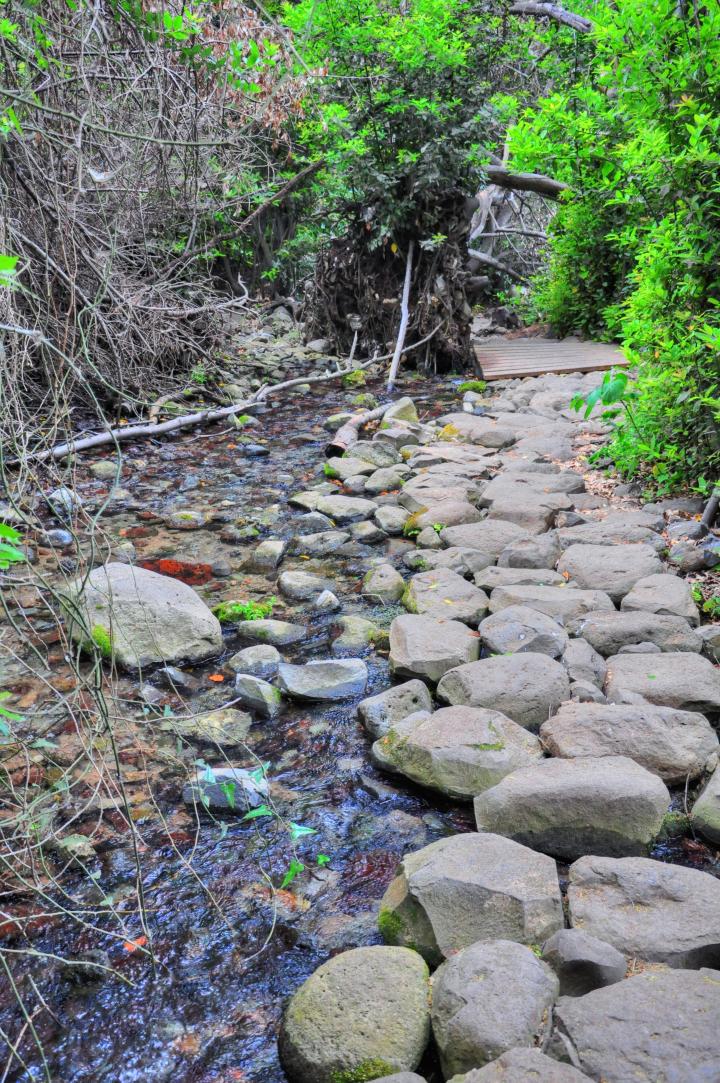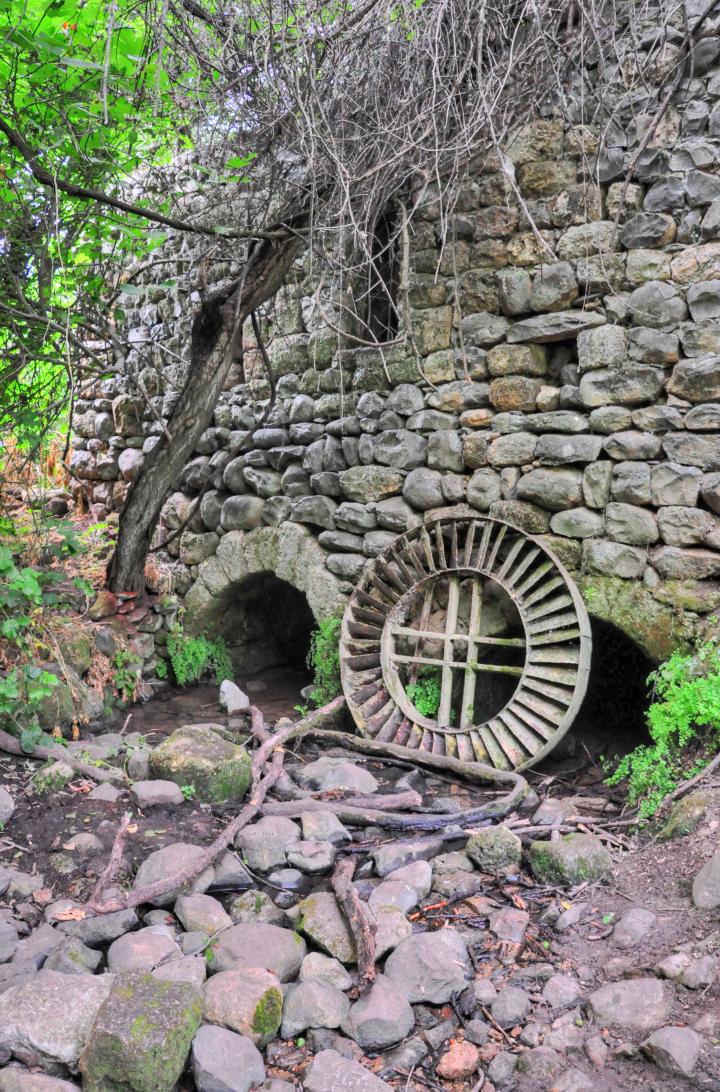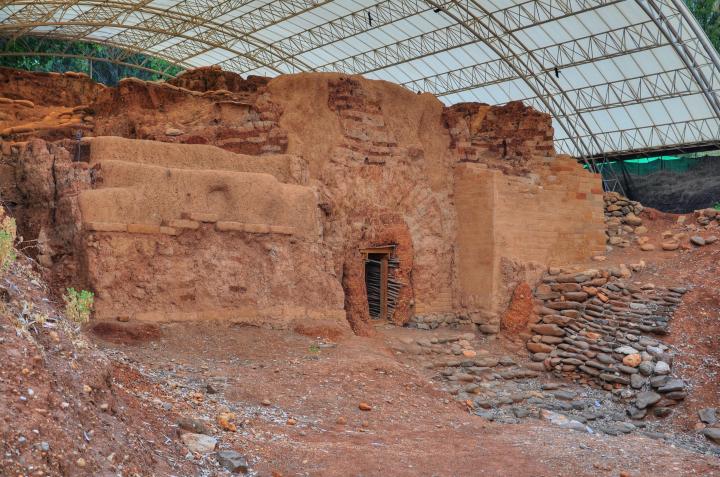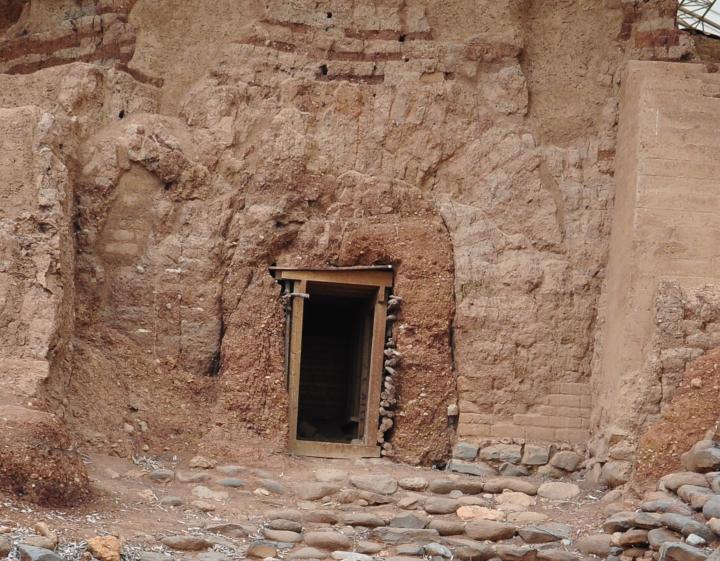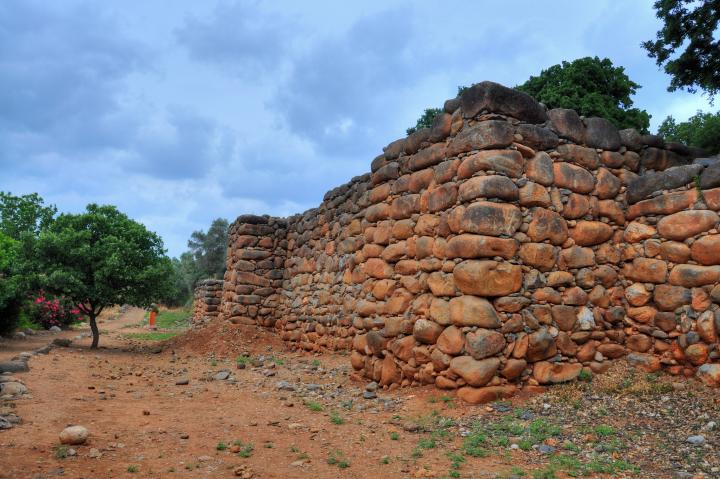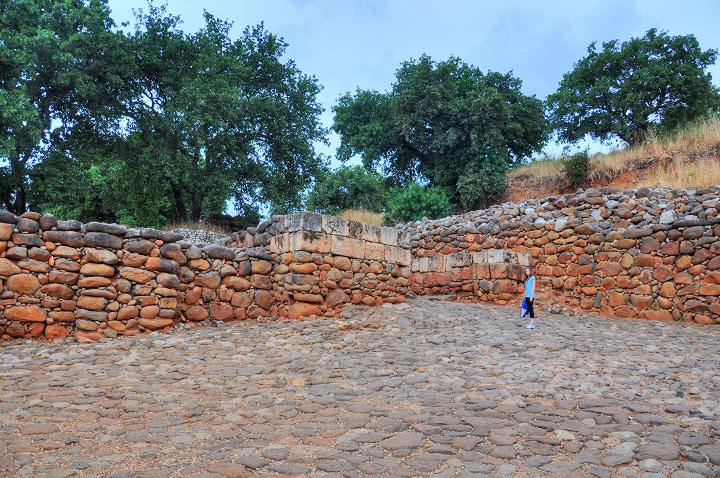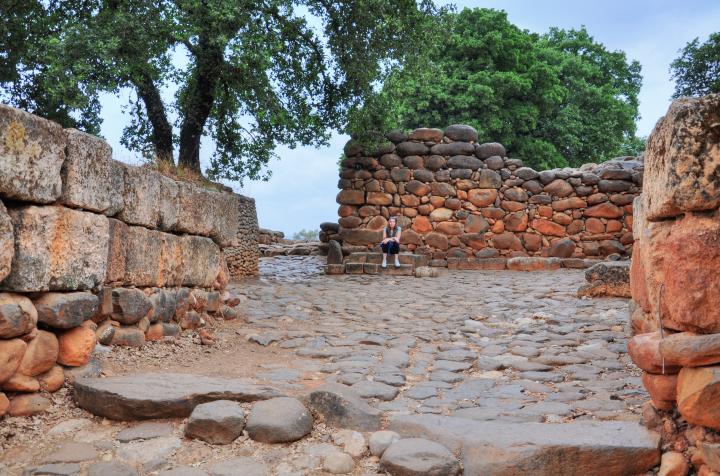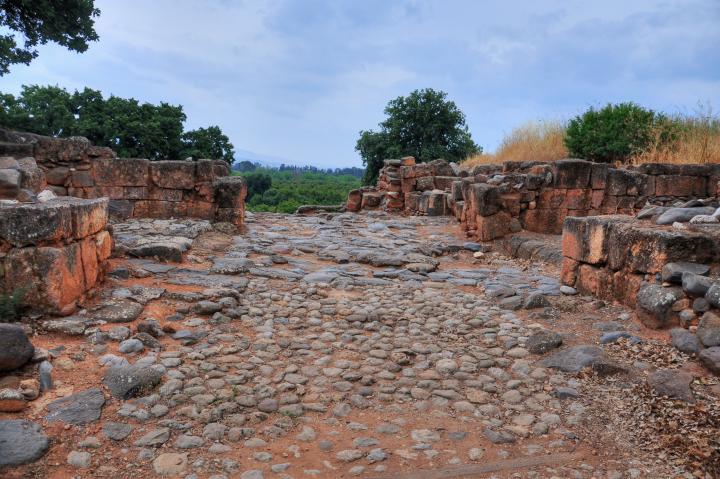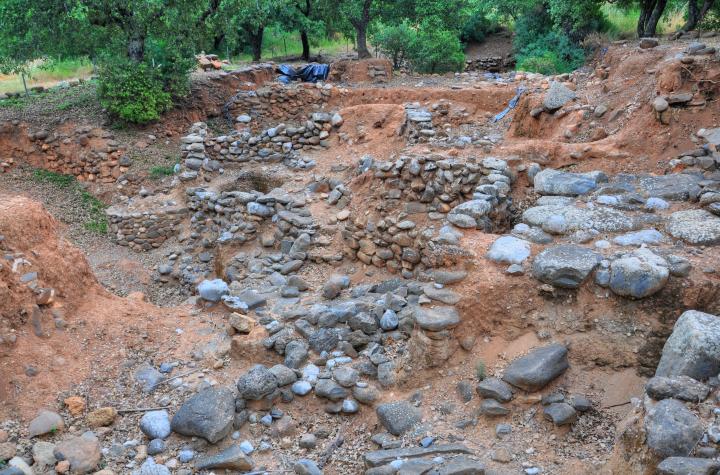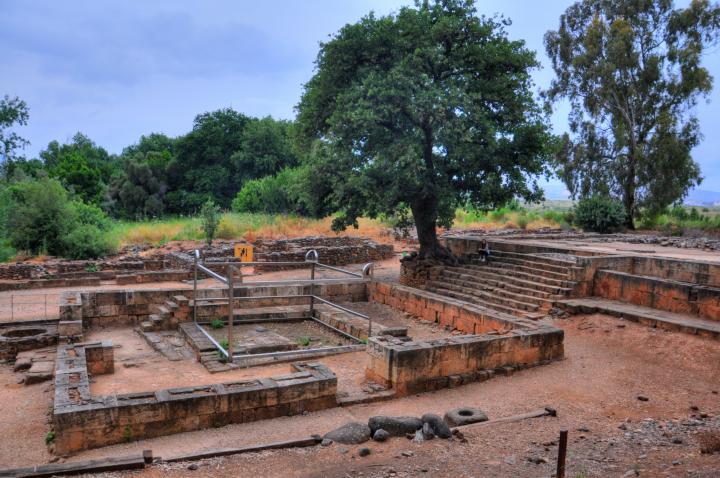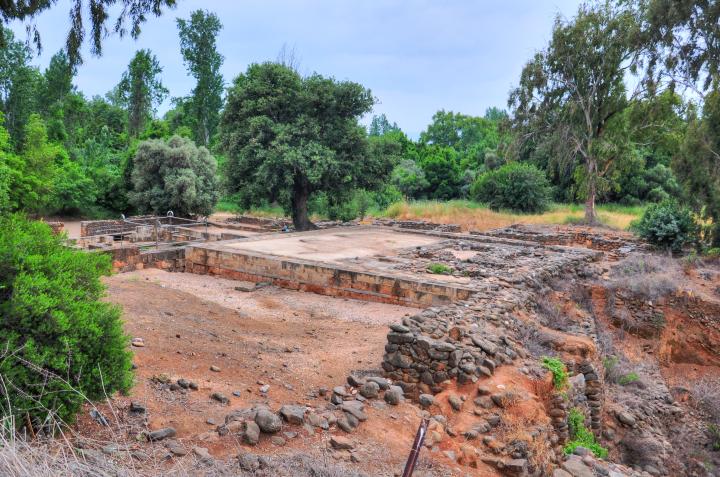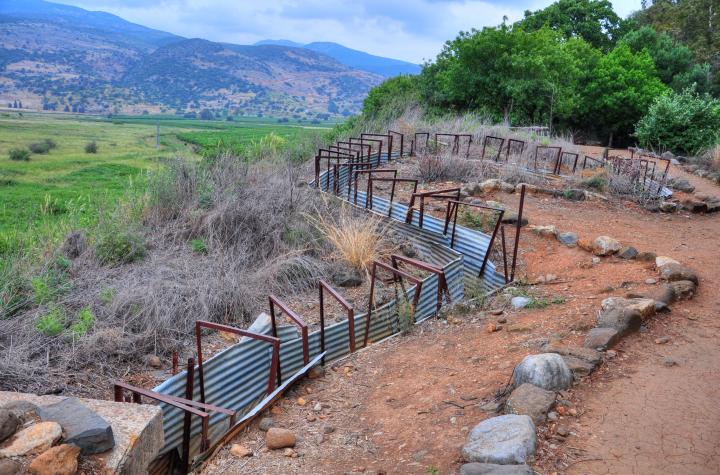A nature reserve and the source of the Dan and Jordan rivers. An impressive archaeological site with unique remains of the Canaanite and Israelite cities and a Biblical High Place.
Joshua 19 47: “…the children of Dan went up to fight against Leshem, and took it… and called Leshem, Dan, after the name of Dan their father”.
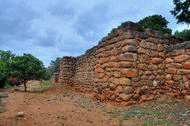
Home > Sites > Upper Galilee > East > Tell (Tel) Dan – Overview page Mega site – 5 pages!
Contents:
Background
Location
History
Photos
* Nature Reserve
* Canaanite
* Israelite
* High Place
* Command Post
Etymology
Links
Background:
Tel Dan is a nature reserve and the source of the Dan and Jordan rivers, located in the northern part of Israel near the border with Lebanon. It is situated at the foot of Mount Hermon and is named after the biblical city of Dan, which was located in the same area.
Tel Dan is best known for its archaeological remains from the ancient Near Eastern period, particularly from the time of the Israelite monarchy. Excavations at the site have revealed the remains of several different cultures and civilizations that occupied the area over thousands of years.
One of the most significant discoveries at Tel Dan is a large stone inscription that dates back to the 9th century BCE, known as the Tel Dan Stele. This inscription is the earliest known reference to the House of David, a dynasty of kings that ruled over the Kingdom of Judah. The stele also provides information about the military campaigns of the Aramean king Hazael, who is mentioned in the biblical Book of Kings.
Other notable findings at Tel Dan include the remains of a Bronze Age city, a gate complex from the Israelite period, and a Canaanite temple. The site is open to visitors and is a popular destination for tourists and history enthusiasts who come to explore the ancient ruins and learn about the rich history of the region.
This is an 0verview page on Dan. Other pages provide more details:
Location and Aerial map:
Tell Dan is located north of Kibbutz Dan. To reach the site, pass the Kibbutz going north, and turn left on the next road following the signs to the Nature Reserve.
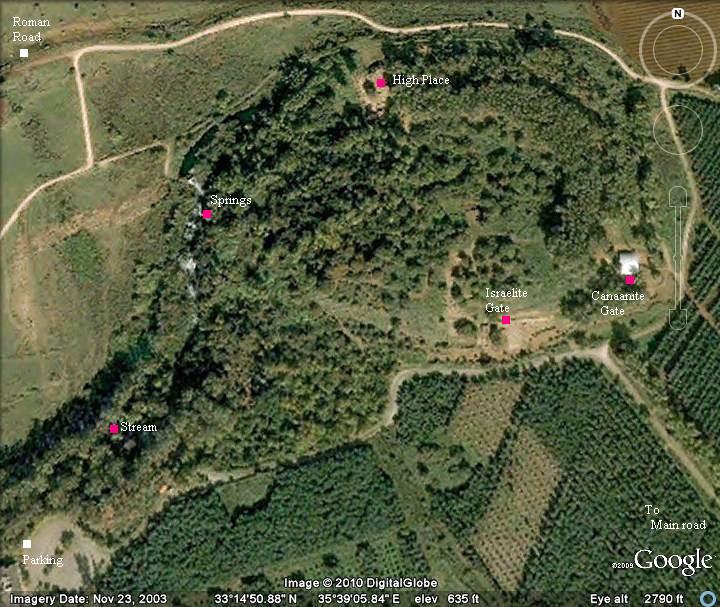
History:
- Canaanite period – Leshem/Laish
Tell Dan was settled starting from the Neolithic period (9th Millennium BC), and became a city in the Early Bronze age (2700-2400 BC). The city expanded and transformed into a large Canaanite city (18th century). The ancient city – named Leshem or Laish – covers a large area: the mount size is 200Dunam (20 Hectares) and was one of the largest in the region. Its high walls, based on a huge earth glacis, protected the city from all sides.
This mighty city was located on the crossroads of major ancient trade routes (see Biblical map below) and dominated the north side of Israel.
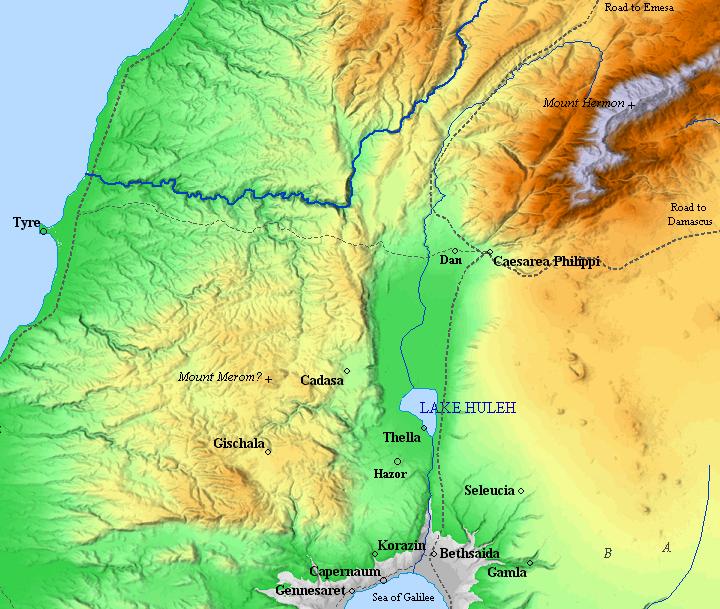
(based on Bible Mapper 3.0)
- Biblical period – Relocation of Dan
A large number of families from the Israelite tribe of Dan relocated during the 12th C from the central region of Israel to the area around the Canaanite city of Laish-Leshem. They were forced out of the center of Israel by the invading Philistines. The area on the foothills of Mt Hermon was a perfect place, since it is located in the heart of a fertile valley with plenty of water coming down from Mt Hermon and the hills around it.
The Bible tells how 600 families of the Dan tribe looked for a substitute for their location in the center of Israel, by sending 5 spies to the Canaanite city (Judges 18 1-2):
“…in those days the tribe of the Danites sought them an inheritance to dwell in; for unto that day all their inheritance had not fallen unto them among the tribes of Israel. And the children of Dan sent of their family five men from their coasts, men of valor… to spy out the land, and to search it; and they said unto them, Go, search the land”.
The spies returned and praised the fertile area (18 9): “…we have seen the land, and, behold, it is very good”.
They later captured the city (Judges 8 27):
“and came unto Laish, unto a people that were at quiet and secure: and they smote them with the edge of the sword, and burnt the city with fire”. The Israelites renamed the city to Dan (Joshua 19 47): “And the coast of the children of Dan went out too little for them: therefore the children of Dan went up to fight against Leshem, and took it, and smote it with the edge of the sword, and possessed it, and dwelt therein, and called Leshem, Dan, after the name of Dan their father”.
-
Israelite Kingdom
Jeroboam, son of Nebat, divided the Kingdom after King Solomon’s death. He established in Dan a substitute worship place for Jerusalem. The Bible described these acts of Jeroboam son of Nebat, erecting a golden calf and building an altar (1 Kings 12 28-31):
“Whereupon the king took counsel, and made two calves of gold, and said unto them, It is too much for you to go up to Jerusalem: behold thy gods, O Israel, which brought thee up out of the land of Egypt. And he set the one in Bethel, and the other put he in Dan. And this thing became a sin: for the people went to worship before the one, even unto Dan. And he made an house of high places, and made priests of the lowest of the people, which were not of the sons of Levi”.
The fortified city of Dan was destroyed in 734BC during the Assyrian conquest.
- Hellenistic and Roman periods
Dan continued to be inhabited until the Roman period. The ritual place served the residents of the city throughout the ages, and was in use until the end of the Roman period.
A Roman road to Tyre passed on its north side. However, the center of settlement moved to nearby Banias (Caesarea Philippi) and Dan declined and abandoned.
- Other periods ( up to 19th century AD)
The city was in ruins since the Roman period, and its location was lost .
The site was examined in the PEF survey (1866-1877) by Wilson, Conder and Kitchener. They correctly identified it as the site of Dan – based on Josephus and other writings – although Kitchener saw few slight ruins on the site. He only writes about a dog’s tomb which turned into a Holy place , called “Sheikh Merzuk” .
Tell Dan appears in the center of this section of the map of 1880 as “Tell el Kady” (mount of the Judge, preserving the Hebrew name of Dan meaning judge). A major river (“Leddan”) flows south-west out of the site, which also preserves the name of the old city (Le-Dan).
The ancient road (dashed line) is seen passing to the north of the site, connecting Banias (east=right) to Tyre (west=left).
Part of Map sheet 2 of Survey of Western Palestine,
by Conder and Kitchener, 1872-1877.
(Published 1880, reprinted by LifeintheHolyLand.com)
- Modern period:
The site was excavated by a team headed by A. Biran (1968-1970) and a new team (since 2005). Some of the archaeological findings are on display in the regional nature and archaeological museum of Beih-Ussishkin, located in Kibbutz Dan.
The nature reserve of Tell Dan is open to the public with a choice of various trails and interests, and is one of the most fascinating sites in the area. It combines both nature attractions – pools, streams, plantations – and historic cities with unique findings.
Photos:
(a) Water and Nature:
The Dan river, originating from the springs at Tell Dan, is the largest of the three sources of the Jordan river. The other two are the Hermon (Banias) and the Snir streams. The waters originate from two springs (Dan and Leshem) which are located on the north-western part of the site.
Click on the photos to view in higher resolution…
The Tell Dan nature reserve, covering a total area of 120 acres, has four nature trails that cross or follow the brooks and water channels amid the dense plantation growing in this wonderland.
An ancient water-powered flour mill is located in the center of the nature reserve. It was built 150 years ago and operated until 1948.
![]() For a detailed description and more photos of the nature sights – see the Nature reserve page.
For a detailed description and more photos of the nature sights – see the Nature reserve page.
(b) Canaanite city:
The abundant source of waters, its strategic location on major ancient crossroads, and the fertile valley around it, were the reasons why a mighty Canaanite city was established here almost 5000 years ago. The Canaanite’s city, known in the Bible as Laish (or Leshem), was a huge city (50 acres). It was heavily fortified by high glacis walls (reaching 10-15 meters), surrounding the whole city from all directions, and is the biggest Tell (ancient mound) in the north part of the Hula (Heleh) valley.
The 18th century BC Canaanite city had an impressive brick gate on its south-east side, 7m high, which was unearthed by the archaeologists.
A stepped path approaches the gate from the east. The gate is built of three arches which were constructed from sun-backed bricks.
The outer arch (2.4m wide) is visible above and to the sides of the entrance in the photo below. The arch-shaped lintel is one of the earliest complete standing arches found in the world, and the archway is the earliest intact structure in the world.
This was the gate where Abraham passed during his pursuit against the North Kings (Genesis 14:14): “And when Abram heard that his brother was taken captive, he armed his trained servants, born in his own house, three hundred and eighteen, and pursued them unto Dan“.
![]() For a detailed description and more photos of the Canaanite/Bronze Age remains – see the Canaanite city page.
For a detailed description and more photos of the Canaanite/Bronze Age remains – see the Canaanite city page.
(c) Israelite city:
The Bible describes the conquest of Laish (or Leshem) by the tribe of Dan. The Israelites rebuilt the city on top of the Canaanite city, and added new basalt walls (seen below) along the earlier walls.
The large Israelite gate, dated to the Kingdom of Ahab (9th C BC), was reconstructed by the archaeologists. A large paved open space (400m2) is located in front of the gate. The main gate, located on the south side of the city, was composed of three pairs of beams surrounding a paved road that enters the city. This design created four guard rooms which is typical of Iron age gates (for example, BethSaida/Zer).
Fragments of a basalt stone with Aramaic inscription, dated to the 9th C BC, was found in the wall. This unique stele includes to a reference to the “House of David”, and parallels to the Biblical description (2 Kings 9) of the murders of Kings Joram and Ahaziah.
The Israelite gate is based on an outer gate, seen below, and an inner gate, which is located on the left of the wall in the center. The processional road winds its way to the left, passing through the inner gate, moving between two pairs of chambers on both sides, then continues into the city.
Opposite the gate’s opening is a base of a canopy, which is based on the flower-shaped stones with top grooves that held the poles. The raised platform may have been the sitting place of the King or Judge (2 kings 23:8): “Then the king arose, and sat in the gate…”.
Behind it, along the wall, is a stone bench – on which the elders of the city sat. This custom is referred in several Biblical passages. Example (Ruth 4 1-2): “Then went Boaz up to the gate, and sat him down there…And he took ten men of the elders of the city, and said, Sit ye down here. And they sat down”.
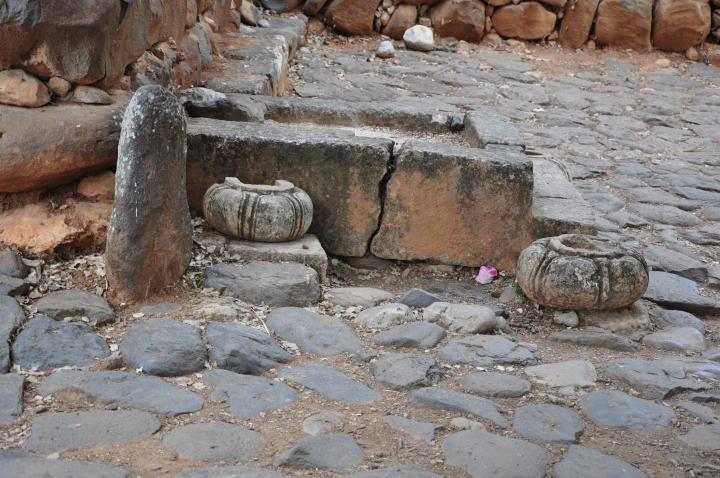
The paved road passes the gate along the south wall. Then, after 70m, it then turns sharply up the hillside (north) as a wide (10m) road, winds around right and left, then enters the city through a secondary gate (seen below from the north side).
Inside the city are traces of ruins, in which the archaeologists excavated residential houses of the city dated to the Bronze (Canaanite) and Iron (Israelite) ages.
![]() For a detailed description and more photos of the Israelite/Iron Age remains – see the Israelite city page.
For a detailed description and more photos of the Israelite/Iron Age remains – see the Israelite city page.
(d) High Place:
On the north side of the mound, above the spring and overlooking the valley with beautiful views of Mt Hermon, is the area (45m x 60m) of the High Place . Here the excavation team unearthed and reconstructed the remains of a unique Israelite ritual place. It was in use since the times of King Jeroboam son of Nebat (930 BC), rebuilt by Jeroboam son of Joash (8th C BC), and reused during the Hellenistic period (3rd C BC) until the end of the Roman period.
The following photo shows a reconstruction of the altar on the left (the metal frame), the houses of the priests (behind the altar), and a large raised platform (“Bemah”, 18.2M x 18.7m) to the right of the great oak tree, with a wide (8m) staircase leading up from the altar.
The Bible described the acts of Jeroboam son of Nebat, erecting a golden calf and building an altar in Dan. The purpose of the ritual place was to serve as an alternative worship site for Jerusalem, after dividing the Kingdom. As per 1 Kings 12 28-31: “Whereupon the king took counsel, and made two calves of gold, and said unto them, It is too much for you to go up to Jerusalem: behold thy gods, O Israel, which brought thee up out of the land of Egypt. And he set the one in Bethel, and the other put he in Dan. And this thing became a sin: for the people went to worship before the one, even unto Dan. And he made an house of high places, and made priests of the lowest of the people, which were not of the sons of Levi”.
![]() For a detailed description and more photos of the ritual site – see the High Place page.
For a detailed description and more photos of the ritual site – see the High Place page.
(e) Modern post:
Tell Dan was a front military post until 1967, when the border with Lebanon and Syria passed at this location. A great panorama of Mt Hermon and the bordering villages in Lebanon can be seen from this abandoned trench, located near the High Place.
Etymology (behind the name):
* Names of the site:
- Dan – Named after the Israelite tribe of Dan, the 5th son of Jacob. It means in Hebrew: “Judge”. As per Genesis 49 16: “Dan shall judge his people, as one of the tribes of Israel.”
- Laish, Leshem – names of the Canaanite city, according to the Bible.
- Dan River – originates in Tell Dan, and is the largest source of water for the Jordan river, and the source of its name.
- Jordan – From Hebrew: Yarden, meaning came from Dan (“Yarad” =went down). Another meaning of the name may be “Yeor Dan”, where yeor is “Nile” – which means river.
- Tel el–Qadi – name of the site in Arabic: Mound of the Judge – which preserves the name “Dan” (judge)
- Kibbutz Dan – established 1939 on the south side of the site.
* Other:
- Hula (Huleh) – The northern valley in the Upper Galilee, 75Km x 12Km. Once a sea occupied the center of the valley, referred in the Bible as Mei-Merom.
Links:
* External sites –
- Tel Dan Nature reserve
- Tel Dan – Archaeology in Israel (2002)
- Dan – the Biblical city
- Tel Dan Excavations blog
- House of David inscription
* More on Dan –
* Nearby Sites –
- Banias (Caesarea Philippi) – replaced Dan as the regional city
* Other Internal sites:
- Flour mills in the Holy Land
![]()
BibleWalks.com – walking the sites of the Bible
Khirbet Tefen<<<–previous site—<<<All Sites>>>—next Upper Galilee site—>>>Dan – Israelite city
This page was last updated on Mar 14, 2023 (new overview)
Sponsored links:
